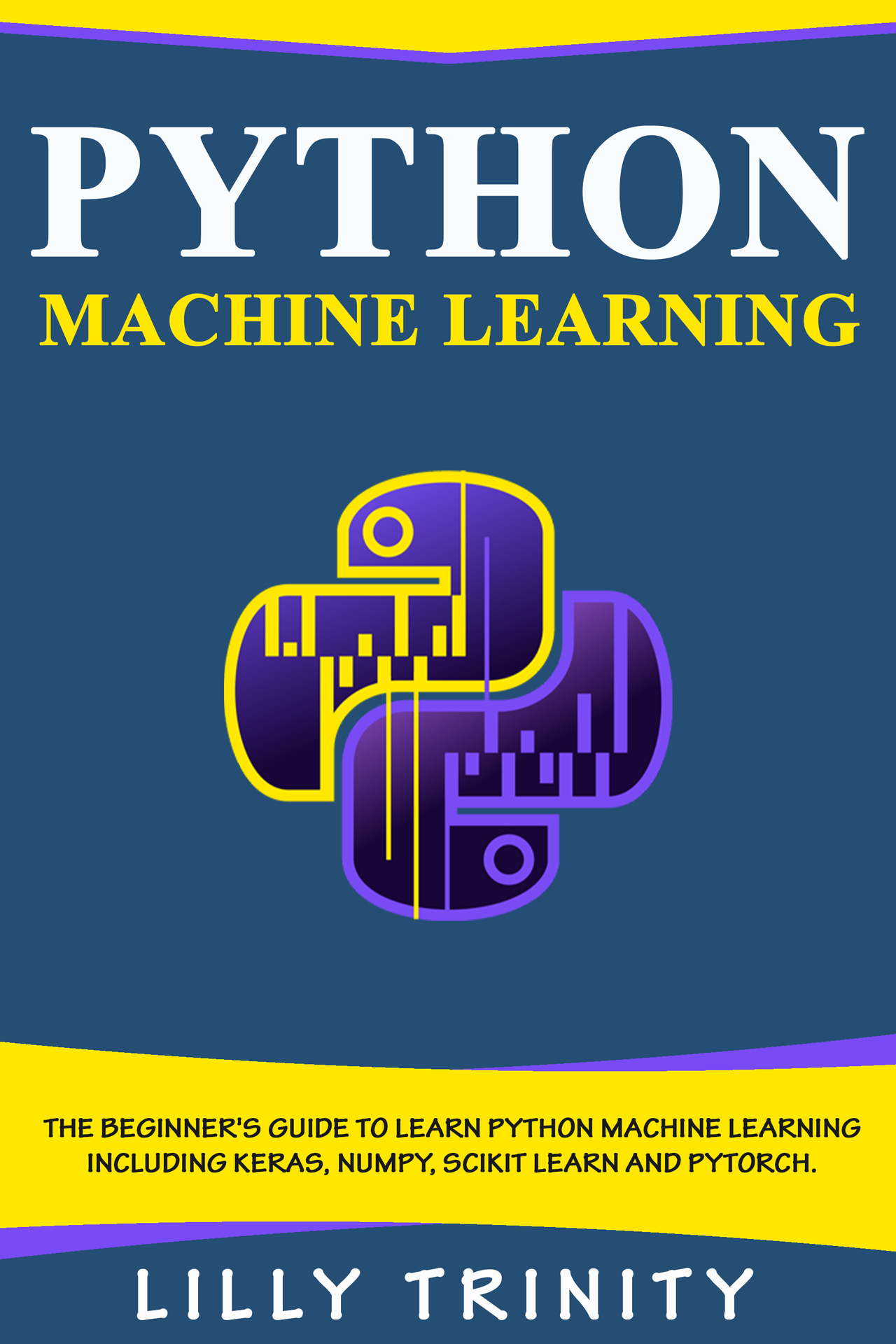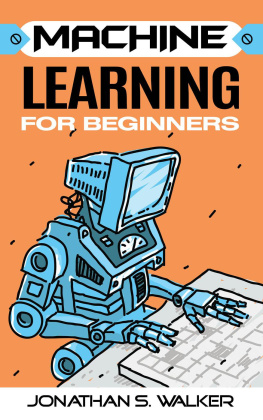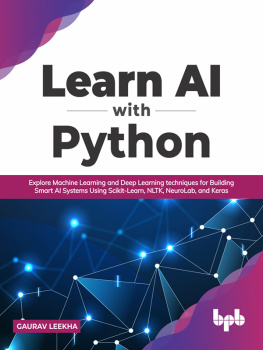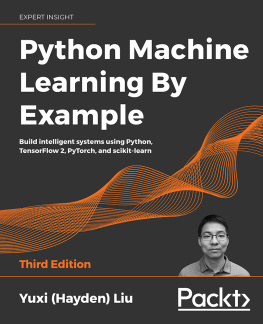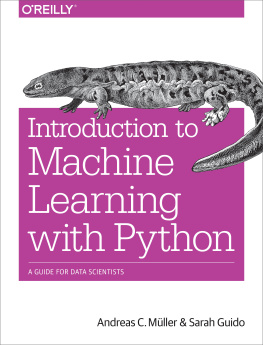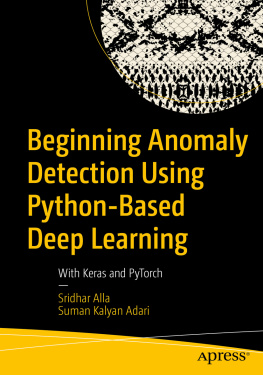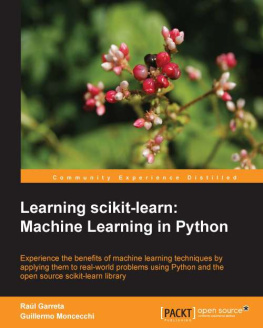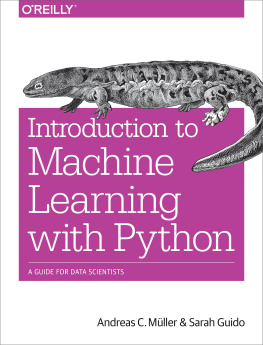Table of Contents
ABOUT THIS BOOK
Python is high-level programming, general- purpose language that is increasingly used in data science and the design of machine learning algorithms. This book gives a quick introduction to Python and its libraries such as numpy, scipy, pandas, matplotlib, and how it can be used to develop machine learning algorithms that solve real problems. This book begins with an introduction to machine learning and the Python language and explains how to configure Python and its packages. It also covers all important concepts such as exploratory data analysis, data pre-processing, feature extraction, data visualization, and grouping, classification, regression, and performance evaluation of the model. This book also features several projects that teach techniques and features such as sorting news topics, detecting junk e-mail, forecasting online ad clicks, stock price forecasting, and several other machine learning algorithms.
We have written this book for professionals who are willing to learn the basics of Python and develop applications and software by making use of the machine learning techniques such as grouping, recommendation, and classification. In this book, you will be taught how to solve data problems and implement your solutions using the powerful but simple Python programming language and its packages. After reading this book, you will get a broad overview of the machine learning environment and best practices for machine learning techniques.
On a technical level, Python is a high-level object-oriented programming language with integrated dynamic semantics, mainly for the development of Web and Web applications. It is extremely attractive in the rapid application development field because it offers dynamic typing and linking options.
Python is very easy to learn because it is relatively simple, but it requires a different syntax, focused on readability. Developers can easily read and translate Python code than other languages. This, in turn, reduces maintenance and program development costs by enabling teams to work collaboratively without significant language and language barriers.
Also, Python supports the use of modules and packages, which means that programs can be designed in a modular style, and that code can be reused in multiple projects. After developing a module or package that you need, you can size it for use in other projects, and you can easily import or export the modules.
One of the advantages of Python is that the standard library and interpreter are freely available in both source and binary form. There is also no exclusivity because Python and all the necessary tools are available on all major platforms. This is an attractive option for developers who do not want to worry about paying high development costs.
If this description of Python on your head, do not worry. You will have understood early enough. What you need to understand in this part is that Python is a high-level programming language which is used to develop software both in an application and on the web, including mobile devices. It is relatively easy to learn, and the necessary tools are available for free for all.
Python is a popular platform which is used for research and development of production systems. It's a vast language with many modules, packages, and libraries that offer different ways to accomplish a task.
Python and its libraries, such as NumPy, SciPy, Scikit-Learn, Matplotlib, are used in science and data analysis. They are also widely used to create scalable machine learning algorithms. Python makes use of popular machine learning techniques such as recommendation, classification, regression, and clustering.
Python provides a structure ready to efficiently perform data mining tasks on large volumes of data in less time. It includes several implementations performed using algorithms such as linear regression, logistic regression, Nave Bayes, k-averages, the nearest neighbor K, and the random forest.
Machine learning, a leading subject in the field of artificial intelligence, has been in the spotlight for some time now. This field can offer an interesting opportunity, and starting a career in this field is not as challenging as it seems at first. Even if you have no experience in mathematics or programming, this is not an issue. The most crucial element of your success is purely your interest and your motivation to learn all these things.
Are you a beginner that does not know where to start his studies? Why you need Machine Learning and why you are gaining popularity, you have come to the right place! We have made provisions for all the relevant information and resources to help you acquire new knowledge and carry out your first projects.
Why Start With Python?
If your goal is to be a successful programmer, you need to know a lot. But for Machine Learning and Data Science, it is pretty enough to master at least one coding language and use it with confidence. So calm down, you do not have to be a genius of programming.
For successful machine learning, you must choose the correct coding language from the beginning, as your choice will determine your future. At this point, you need to think strategically, organize priorities correctly, and not waste time doing unnecessary things.
My opinion - Python is the ideal choice for beginners in the field of machine learning and data science. It is a minimalist and intuitive language with a complete library line (also called framework) which considerably reduces the time needed to obtain the first results.
Understand Why Python Is So Cool
Many programming languages are available today. A student can spend an entire semester at university and study computer languages without always hearing from everyone. (That's what I did during my college years.) One would think that programmers would be satisfied with all these programming languages and would choose only one to talk to the computer, but they would continue to invent more.
Programmers continue to create new languages for a good reason. Every language has something special to offer - something that does exceptionally well. Also, as computer technology evolves, programming languages evolve. Because creating an application relies on effective communication, many programmers are familiar with various programming languages to choose the right language for a specific task. One language may work better to obtain data from one database, and another may very well create user interface elements.
As in any other programming language, Python makes some exceptions, and you need to know what they are before you start using it. You might be surprised by the cool things you can do with Python. Knowing the strengths and weaknesses of a programming language allows you to use it better while avoiding the frustration of not using language for tasks that do not work well. The following sections help you make these kinds of decisions about Python.
Discover the Reasons to Use Python
Most programming languages are designed with specific goals. These goals help you define language characteristics and determine what you can do with the language. There is no way to create a programming language that does everything because people have conflicting goals and needs when designing applications. The main goal of Python was to create a programming language that would make programmers efficient and productive. With this in mind, here are the reasons why you want to use Python when creating an application:

